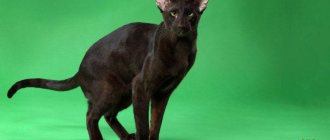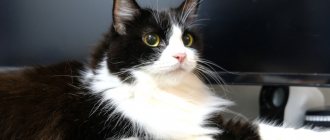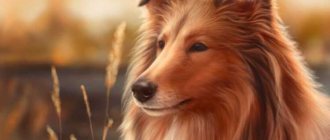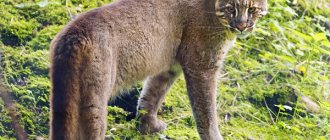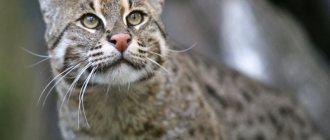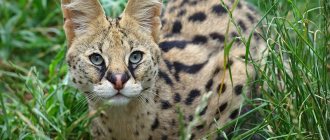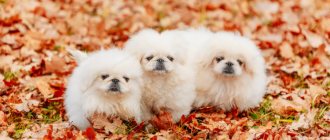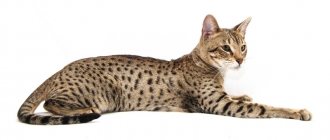Now there are very few animals left in nature, so they are listed in the Red Book. What does a Chinese mountain cat look like? What does she eat? How does it raise offspring? Is it possible to keep a predator at home? Is there a domestic breed of Chinese cat?
History of the discovery of the species
It is not known for certain where the animals came from; they approximately inhabited the territory of China long before the appearance of people and lived in desert areas. The separation of the Chinese and European (forest) cats occurred 230 thousand years ago. The cat was first described by the French zoologist and naturalist Henri Milne-Edwards in 1892. These animals lived in China long before the appearance of pets in Europe, where they were brought after the opening of economic borders.
Today, the Desert Cat is a small species, numbering from 2,500 to 10,000 adult individuals according to various sources, and these data are inaccurate. Not all animals have been domesticated by humans; small groups live in the remaining undeveloped areas of China.
Today they are facing extinction, as residential and industrial buildings occupy new territories every day, leaving no room for wildlife.
Li Hua
Chinese Li Hua has a completely different name in China. She is also considered one of the most popular and youngest cats. This is due to the fact that the breed was officially registered only in 2010. However, the first mentions of this cat are found in ancient books. This indicates the antiquity of the breed.
The main color of the animal is brindle; it does not exist in other variants. It should be noted that the stripes that are on the wool have a pronounced character. This indicates the authenticity of this representative.
The Chinese cat has very interesting eyes. They are Asian in shape, but quite large. Often there are representatives of the breed with green eyes. But you can also find brown, yellow and brown eyes in these cats. The ears are round in shape.
Mr. Cat recommends: characteristics, habitat
The appearance of the Chinese mountain cat is not much different from the domestic animal we are used to. It is larger than its European counterparts, but very similar to them. In addition, he is practically a copy of the jungle cat, although his paws are slightly shorter, but he also has tufts on his ears. The animal's muzzle is extended forward, its coat color is yellowish-red with characteristic stripes. By the way, in Chinese the name of the species sounds like huang mo mao, which means a cat with yellow fur.
Forest or European cat
jungle cat
Chinese cat
In addition, we can say that the Desert Cat is similar to a lynx, only different in size. The tail is thick with black transverse rings located towards the end.
Wild individuals reach up to 1.4 meters in length including the tail (it is 25-35 cm) and weigh 6-9 kg. Males are larger than females.
In nature, they can be found in the northwestern part of China. The animals live in steppe and mountainous regions near the border of Tibet and in southern Mongolia.
Observations by local residents indicate that Gobi cats live in extreme conditions at an altitude of 2000 to 4000 meters above sea level in the steppes of the foothills. Sharp temperature changes reaching critical levels in winter and summer, strong winds - these are the conditions chosen by the most ancient representatives of the cat family.
In the process of evolution, the fur of these animals became denser and thicker, and peculiar slippers were formed on their paws, protecting the pads from cold and heat.
Previously, the animal was an object of hunting. As a result of this, and also due to the mass extermination of rodents that the animal ate, the number of Mountain cats decreased. Now they are under state protection and are listed in the Red Book as an endangered species.
Popular colors of Japanese Bobtails
There are a lot of colors of Japanese bobtails today.
The most popular and generally recognized colors are:
- Monochrome - can be white, black and red. Minor inclusions of other colors are allowed. For example, in a black coat, small white markings on the chest are allowed. In a completely white color, the tail sometimes has a reddish tint, and a small red spot is also allowed on the back of the head or on one of the ears;
- Bicolor is a color with a combination of two colors. The most common combination is a white background with red or dark splashes. Bobtail spots are not symmetrical and small. They are most often located on the back, neck, head and tail. Sometimes it is a black background with white spots on the paws and chest;
- The Mi-ke's color is a combination of black and red spots on a white background, as well as dark striped areas. This is an extremely rare cat color that is often found among Japanese Bobtails. It is considered the most original and beautiful color for this breed;
- Striped Bobtails are rare and not recognized by all organizations; Tortoiseshell or Calico are completely tri-colored bobtails. Only females are tricolored; sometimes this color is accompanied by pathology in the form of deafness. Although in Japanese bobtails this defect is most rare.
In addition to the permitted colors, there are a number of prohibited colors in Japanese Bobtails, which mark them as not purebred cats. These colors include chocolate, tabby, lilac, and blue. Today, there are discussions about lifting restrictions on the colors of bobtails, since apart from their colors, these cats are no different from “purebred” bobtails.
Chinese "dragon" with a bunch of names
The Dragon Li cat breed has many names in Chinese sources, but is more often referred to as Li Hua or Li Mao. These felines became especially popular in 2003, when they were first presented at an international exhibition. After that, they gained popularity in the USA, but in Russia they never took root (due to their similarity with ordinary “yard” cats). Due to its striped appearance, the Li Dragon is the "image of the tiger" to the Chinese - symbolizing fearlessness, ferocity and military prowess. It is also believed that his image drives away evil spirits. In this connection, cats of this breed are a talisman and a talisman of housing for the Chinese.
All representatives of Dragon Li are strong and muscular animals of medium size. The weight of males can reach 5 kilograms, and females up to 3.5 kilograms.
The appearance standard of the Dragon Li breed can be described by the following characteristics:
- The head is elongated towards the nose, with a rounded occipital part. The corners of the mouth are highlighted in black, which creates the impression of a “smile.” Be sure to have a dark tip of the nose - this is one of the distinguishing characteristics of the breed. The eyes are set slightly obliquely (the outer corner is always lower than the inner) and almond-shaped. Mostly presented in yellow or green shades (they stand out brightly against the background of the color of the coat).
- The ears are large but proportional. At the base they are quite wide with a rounded top.
- The body has a slender, proportional body, with a prominent broad chest. The back is straight.
- The limbs are set straight, powerful, of medium length (the front legs are slightly shorter than the hind legs). The feet are oval wide in shape (there are 4 toes on the back and 5 on the front).
- The tail is wide and massive, gradually tapering towards the end. It is shorter in length than the body.
- color is brindle with stripes and dark spots (the pattern is sure to stand out and be clear) in the colors “brindle black tabby” and “broken chocolate tabby”. There are ringing stripes on the head, body, chest, neck and tail. And on the chest they are presented in the form of a necklace.
- the coat is dense with a faint undercoat. It looks smooth and short with its characteristic shine.
- long wool;
- malocclusion;
- large ears;
- nose without darkening;
- extra fingers;
- there is no characteristic “necklace” on the chest;
- overweight;
- non-standard eye shade;
- fuzzy fur pattern;
- lack of slanting.
According to the standards, individuals with the following characteristics are rejected:
All of the above can serve as evidence of the absence of a breed or mixing with other species.
History of the Japanese Bobtail breed
Japanese bobtails are over a thousand years old. It is assumed that the first mustachioed mousecatchers arrived on the islands from China, but they looked different then, and their tails were initially of normal length. Subsequently, as a result of a gene mutation, this part of the body lost the appearance to which we are accustomed. Thus, the classic tail was replaced by a short “squiggle”, disguised with airy fur as a “pompom”. The Japanese, steeped in folk signs and superstitions, considered this change a good sign: long tails in this part of Asia were never welcomed and were identified with a dark, evil entity. Well, since this part of the spine of the bobtail ancestors had insignificant dimensions, the bobtail cats were given the “green light” to reproduce.
In national culture, traces of Japanese bobtails can be traced back to the 16th century, when Asian artists discovered ideal sitters in cats and began to depict them on their canvases. By this time, bobtails managed not only to gain the trust of the Japanese rulers, but also to completely occupy the palace chambers and country residences of the emperor, as well as his entourage.
It is unknown how long the breed would have managed to maintain its privileged status if not for the large-scale invasion of rodents that invaded the Land of the Rising Sun in 1602. Driven by hunger, the rats mercilessly dealt with the food supplies of the townspeople, mulberry trees and even silkworm larvae. To stop the mouse chaos, the emperor made an extraordinary decision: the ruler issued an urgent decree ordering cat owners to release their furry charges onto the city streets. Thanks to this, Japanese bobtails received complete freedom of action in terms of reproduction and “pumping” of the genotype.
The breed owes its move to the USA and European countries to the American breeder of Abyssinian cats and part-time leading CFA specialist Elizabeth Freret. Despite the fact that Japan’s self-isolation had sunk into oblivion by that time, Asians were clearly in no hurry to share their bob-tailed mousetraps with the rest of the world. However, in 1967, the woman managed to buy three Japanese bobtails and deliver them to America. Subsequently, Mrs. Freret’s mustachioed “troika” was joined by several more short-tailed purrs, almost smuggled out of Japan. They later became the main producers of the American line of the breed.
In 1968, the Japanese Shorthair Bobtail was standardized with CFA registration. This was serious progress, since in the homeland of cats they were not keen on maintaining documentation, preferring to breed animals without any paper formalities. As for long-haired individuals, their path to recognition by felinological associations turned out to be several decades longer. At first, overly fluffy kittens that slipped through litters of bobtails with short fur coats were mercilessly culled. However, after turning to historical sources, it turned out that at the court of the Japanese emperor, long-haired bobtails were bred on a par with their short-haired counterparts. As a result, the variety received the right to exist only in 1991, and then after persistent requests from breeders.
Features of behavior
Like all representatives of the cat family, animals are predominantly nocturnal. At dusk, you can spot a beautiful predator in the bushes waiting for prey. Cats are secretive, leaving their home with extreme caution, trying to make it as secure and unnoticeable as possible. Hollows and crevices are chosen for homes; these are mainly refuges for males. Females prefer burrows with a complex branched system and several exits. They carefully protect their habitat; offspring are bred here, which are encroached upon not only by people, but also by large predators such as bears and wolves.
Mountain cats are solitary and rarely gather in packs, only for the breeding season. The rest of the time they live in solitude, guarding with all zeal the boundaries of the territory, which can occupy up to 15 square meters. km.
Domesticated individuals are distinguished by an easygoing disposition, affectionate and surprisingly devoted to their owner. This trait, unusual for the cat family, attracts breeders. Despite this, Chinese cats can be aggressive, so they are not recommended for families with small children.
Animal habitat
The species' habitat covers a small area. Cats prefer mountainous areas. They can be found in the northeastern Tibetan mountains, southern Mongolia and northern China. Representatives of this species inhabit steppe and mountain areas, and also settle in areas with bushes.
The animal is nocturnal and camouflages itself very well, so it is almost impossible to study its habits in the wild. All descriptions are based on observations of zoo inhabitants. Males and females live separately; they spend most of the day in burrows that they create themselves. Females have deeper and more protected burrows. The living space of one individual is 12–15 square meters. km.
Puberty and reproduction
Chinese mountain cats breed in nature from January to March inclusive. During this period, animals gather in small flocks. Young animals reach sexual maturity early; already at 8-12 months they are capable of independent life and reproduction.
Pregnancy in a female lasts up to 2.5 months. During this period, the cat prepares a hole, landscaping it and creating a network of tangled passages for protective purposes. The offspring will appear in a secluded place at the right time, usually 2-4 babies. Breastfeeding the cubs does not last long; very soon young cats begin to learn to hunt under the control of their mother. By 7 months of age, the animals are completely independent and leave to look for their territory.
Vaccinations and antiparasitic treatment
To maintain health, your Chinese cat should be vaccinated against infectious diseases in a timely manner. The first vaccination is carried out at the age of 3–4 months, repeated ones are done once a year.
Kittens must be vaccinated against the following diseases:
- rabies;
- calcivirosis;
- panleukopenia (distemper);
- chlamydia.
Vaccinations are given only to healthy cats. Deworming is carried out first. Chinese cats that are outdoors must undergo therapeutic and preventative treatment for fleas and other skin parasites.
Captivity
The Chinese desert cat is listed in the Red Book, so keeping an animal at home is punishable by law.
Despite the prohibitions, you can find exotic animal babies on the black market. When purchasing a wild animal that is not adapted to living at home, you need to understand that improper care, territorial limitations and nutrition can lead to negative consequences.
A Chinese cat, accustomed to freedom and harsh natural conditions, can get sick and die in the house.
When feeding domesticated predators with natural products, the owner faces difficulties in selecting and balancing the diet, but for experienced breeders this is not a problem.
Education and physical activity
Chinese cats are very smart and easily learn to use a litter tray and scratching post. If desired, your pet can be taught to perform simple tricks. When raising a cat, you need to be patient; you cannot shout at him or use force. If you motivate your pet with treats, you can achieve good results in training.
Chinese cats are naturally highly active. You will have to walk your Li Hua regularly to keep her in good shape. If the owner does not have the opportunity to often go outside with the cat, then a play complex of 2-3 tiers with ladders and tunnels should be installed in the house. It would be good if it had a running wheel.
What to feed
The diet depends on the age, sex and health of the individual. Li Hua have an excellent appetite, but they are not overweight.
They are usually fed warm food in the morning and evening. You can use ready-made premium, super premium or holistic food or natural products. Mixed food is allowed, but it is imperative to serve them at separate times: artificial and natural food.
Meat, vegetables and cereals are boiled before serving. Fruits, fatty and sweet foods are not included in the diet. Dairy products - only low-fat and not very often. Fish and chicken bones are not given. Constant access to drinking water must be provided.
Care and maintenance
First of all, you should clearly decide on your diet: natural food or ready-made food, because...
Mixed nutrition is extremely undesirable for this breed. When making a choice in favor of natural food, you should adhere to the following recommendations:
- Give the greatest preference to meat and sea fish.
- Raw foods should be kept in the freezer for several days and cooked at least a little before serving. This will reduce the risk of the animal becoming infected with parasites.
- Dairy products and vegetables containing large amounts of carbohydrates are contraindicated for representatives of this breed; they can lead to the development of diabetes in the animal.
- It is strictly forbidden to feed cats table scraps.
- Adult animals should be fed 2 times a day.
If we talk about ready-made food, then only holistic or premium food is suitable for bobtails. Feed should be introduced into the diet carefully, because they can cause allergies. Your veterinarian will help you choose the right food.
Grooming
These cats are clean and take good care of their fur. They hardly shed, and in order for their coat not to cause discomfort to the owners, it is necessary to take into account that caring for the coat will depend on its length. You must adhere to the following recommendations:
- For short-haired bobtails, brushing with a special mitten is sufficient.
- Long-haired animals need to be combed 2-3 times a week.
- During molting associated with growing up, when the animal changes its “baby” hair to a new one, a furminator (a special comb for pets that makes it easier to comb out the hair) can come in handy. In childhood, there is practically no strong shedding.
Otherwise, if you choose the right food for this breed and provide timely care, there will be no problems with your pet’s fur.
How to bathe
Representatives of this breed love to swim, although this is not always necessary. Animal fur does not have an unpleasant odor, and cats should be washed only if there is visible dirt on it.
It is recommended to carry out the bathing procedure as follows:
- First, you need to apply disinfectant paste to dry wool and leave for 5-7 minutes.
- Then rinse the fur with a soft sponge so that the paste is thoroughly washed off.
- Afterwards, apply shampoo, lather well and rinse thoroughly.
- If necessary, additional care products can be used. You can use wool conditioners, etc.
At the end of the water procedures, the wool is wiped with a towel and dried with a hairdryer using a comb.
Ear care
Recommendations for caring for your pet's ears:
- You need to clean your ears using cotton swabs and special products.
- The use of vinegar, peroxide, alcohol and other aggressive substances for this purpose is strictly contraindicated. This may harm the cat's health.
- You should clean only the outer part of the ear, without using excessive force.
A large amount of hair in the ears negatively affects their hygiene, so it needs to be trimmed from time to time.
Eye care
Recommendations for eye care for bobtails:
- Use a cotton swab to clean the eyes. It is moistened with special eye drops for animals.
- Paper towels cause irritation to the mucous membranes, so their use is undesirable.
- If a foreign body gets into your cat's eye, you should rinse it with warm boiled water.
Dental hygiene
Brushing teeth is an important part of caring for your pet. Plaque should be removed regularly; to do this, use the following recommendations:
- Kurilian Bobtail kittens brush their teeth with a finger. It must be wrapped in soft cloth.
- For adults, use a special toothbrush and toothpaste.
- You can use specialized dry food to clean your teeth.
It is advisable to undergo an examination at least once a year by a veterinary dentist, who will be able to promptly identify and eliminate problems with the animal’s teeth.
Purchasing a kitten
Purchasing a wild animal with the character of a predator is a responsible decision. The animal needs a large territory and loneliness; individuals, accustomed to living alone in nature, are forced to be in the spotlight and show aggression.
It is especially dangerous to keep a Mountain Cat with other animals. Pets will conflict and can cause irreparable harm to each other. Victory will be on the side of the wild animal, which is stronger and larger than domestic ones.
Breeders need to know that sterilization of the Chinese mountain cat is contraindicated. He does not tolerate anesthesia well and if he survives, his character changes for the worse. Keeping such animals outside the cage is dangerous for the owner.
When purchasing a pair, even experienced breeders take risks. It is impossible to be sure that animals will be able to reproduce in captivity, since the choice of a mate in cats usually occurs during the breeding season. During the rut, animals that have not found a mate become aggressive towards their own kind, and at home they can attack the owner, perceiving him as a rival.
There is no question of the Mountain Cat living in an apartment. This is deliberate murder. Living in a closed space leads to illness and death of the pet. It is impossible to toilet train an animal; it will mark its territory no matter what, as this happens in nature.
Considering the characteristics of the animal, it is better to leave it to live in nature or, in extreme cases, in a reserve or zoo with excellent conditions and competent specialists. For the home, it is recommended to purchase artificially bred breeds adapted for small spaces and constant contact with humans.
Enemies and food
Unfortunately, the Chinese cat breed receives the predominant percentage of dangers from humans. This is due to the constant hunting of its representatives and the spread of poisons dangerous to it.
The first and main reason for the decline in the population of this breed is the almost complete elimination of prey. Back in 1958, instructions were given to destroy all rats and rodents. This would significantly reduce the number of zokors, which posed a direct threat to livestock. The main chemical used to exterminate them was zinc phosphide. Over time, it was no longer used because scientists had proven its harmful effects on all carnivores that consumed rodents as food.
This Chinese cat with big eyes, in addition to the animals presented, also consumes rabbits, pheasants and other representatives.
Breeds derived from the Chinese Mountain Cat
For exotic lovers, special breeds were bred from crossing with the Chinese mountain cat, capable of living in houses and apartments:
- Li Hua or Dragon Li is distinguished by an elongated muzzle and rather large ears. The color is spotted or striped, the main shade of the coat is brownish-red. This breed is attracted by its unusual amber eye color.
- The Li Mao or Chinese Fold is not an officially registered breed. It is believed that cats with floppy ears can only be Scottish. How Li Mao appeared is unknown. The color of the animal is grayish-brown with dark stripes. The tips of the ears are black.
Artificially bred pets are different from wild mountain cats. The animals are smaller in size and only resemble their relatives in color. They are not fussy about their diet and have a good appetite. For them, a diet is prepared based on industrial feed, canned food or ordinary products prepared independently. The choice of food depends on the characteristics of the animal. That is, they take into account the animal’s lifestyle, whether it is sterilized, as well as its age and build.
Character and habits of Siberian cats
Siberian cats are smart, think quickly, and are endowed with a strong hunting instinct. At the same time, they become attached to the owner and members of his family, showing friendliness and sociability to a greater extent than representatives of many other breeds. It is believed that their character has quite a lot in common with that of a dog.
Thus, they treat strangers with suspicion, reminiscent of guard dogs. Of course, they won’t growl at strangers or bite them unless they show aggression themselves, but at first they will look at guests with wariness and will not want to be picked up.
If the owner is not interested in her, the Siberian cat will not run around him and demand to play - she will go about her business or just sleep. Often at the same time he falls apart on his back and raises his paws up. Loves to bask in the sun in funny poses.
Sometimes it happens that the owner himself decides to cuddle her, but she is not in the mood: in this case, it is better to leave the cat alone, otherwise she may get angry. They don’t always get along with other pets: some easily accept new members into the family and even protect them from strangers, others hurt smaller cats and even small dogs.
In general, they often conflict with dogs: even if they are larger, Siberian cats often begin to bully them and try to show that they are the owners of the house. They tend to hunt various hamsters and rats and refuse to admit that these are pets and not prey that has sneaked into the house.
Character
Cats of the Li Mao breed are highly active and friendly. They do not show intrusiveness or aggression. They get along well with other animals... and, at the same time, are considered unsurpassed hunters - owners of pet rats, guinea pigs, hamsters, etc. need to take this into account.
It is better to have a pet of this breed in a house where there are no very small children (since “dragons” do not like excessive squeezing and caressing).
Also, Li Hua are very smart and loyal cats and are quite trainable. It is quite easy to train them to go to the litter box or sharpen their nails on a special scratching post.
The Li Mao breed is perfect for keeping in a small apartment. If the owners are on duty during the day, they can tolerate loneliness without any problems.
Table: advantages and disadvantages of the Li Hua breed
| pros | Minuses |
|
|
Interesting Facts
Many sites write about supposedly another breed of Chinese cats, Maneki-neko, a symbol that brings happiness. In fact, this figurine, which is often made of porcelain or ceramics, came from Japan, not the Middle Kingdom, and looks like a cat waving its paw. It is sold in souvenir shops and is believed to bring prosperity and happiness to the home.
The history of Maneki-neko began in the early 17th century, when one poor monk sheltered a wild mountain kitten dying of hunger. The temple in which the man lived was in a terrible state. One day, out of melancholy and hopelessness, the monk spoke to the animal, saying that he did not blame him for being useless, but if the cat were a person, he could be more useful.
The next day a thunderstorm broke out. A prince was driving past the monastery and saw a Chinese cat on the road waving its paw. The beast showed the way to the shelter, where the traveler found food and shelter. The next day, a wealthy guest allocated funds for the restoration of the monastery.
Since then, Maneki-neko has been in every home and it is believed that happiness and good luck always follow it.
History of the origin of the breed, its distribution and official recognition
The Thai cat is an aboriginal breed, originally from the Hindustan Peninsula. The oldest images of a cat of a characteristic phenotype date back to the 14th century and are illustrations to the ancient manuscript “Smut-hoi” (“Book of Poems about Cats”) from Ayutthaya, which contains not only images, but also detailed text descriptions of Thai cats. The manuscript is kept in Bangkok, in the National Laboratory Museum. Over the past half a thousand years, the phenotype has remained virtually unchanged - in photographs of the late 19th century, representatives of this breed look almost the same as their modern descendants.
Photo from Rose Tenent's book “The Book of the Siamese Cat”
Thai cats came to Britain at the end of the 19th century. Most likely, they were brought by members of the diplomatic mission. In 1892, the British felinologist Harrison Vere approved the standard of “royal cats from Siam.” In 1901, the English Siamese Cat Club was organized, and the following year the breed standard changed significantly, approaching the modern one.
It is important to note here that the breed, known today as Thai, was originally called Siamese, after the name of the country of origin, however, through the efforts of breeders, representatives of this breed received a number of significant differences, so that the modern Thai cat is a Siamese cat of the old, original type
An image clearly illustrating the characteristic differences between Thai and Siamese cats
Siamese cats of the modern type were brought to America, where, as a result of further selection, the final phenotypic separation of Siamese and Thai cats took place. The original phenotype was preserved in Siam itself and, interestingly, in Russia, where Siamese cats appeared at the end of the 18th century. The meeting with them was described by Peter Pallas, who traveled through the southern provinces of the Russian Empire in the second half of the 18th century. The cats he met lived in the Caspian village of Insar. They had a very dark color, but this is associated with a colder climate, because the color of the fur of Siamese cats depends on the ambient temperature.
Officially, Siamese cats came to Russia as a gift to Nicholas II from Chulalongkorn, King of Siam. Then the emperor was sent two hundred Siamese cats of the original phenotype, which became the basis of the population of these animals in Russia. Despite the fact that the official selection of representatives of this breed began only in the 80s of the twentieth century, they lived in many families, and they preferred to breed representatives of this breed with similar animals, so the breed retained its purity.
A characteristic representative of the Thai cat breed of the original phenotype
The breed standard was officially included in the WCF system in Germany in 1990. The name of the breed was chosen in honor of the modern name of the kingdom of Siam - Thailand.
The breed is considered closed, but with the participation of the local felinological club and independent experts, an outbred animal that meets the established breed standards can be recognized as purebred and receive a zero pedigree.
Description
Chinese cats are currently little studied; their habitat is desert areas. At the moment, Chinese cats are endangered. Due to overdevelopment in the Republic of China, natural habitats are suffering greatly. These cats are very sociable, affectionate, gentle and incredibly devoted to their owner. But due to the fact that cats were domesticated later than their European relatives, their character remained independent.
They treat children very patiently, but it is better not to have such a four-legged friend in a house where there are children. They get along well with other animals. These cats have not yet been studied well, so it is difficult to judge their pain; in general, the physiological component is normal.
They are not fussy about their care and do not require constant care and supervision.
The cat looks like this:
- The animal's height ranges from 27 to 35 cm, weight - from 3.5 to 5.5 kg.
- The body shape is elongated, proportionally muscular, with a large chest, not very long legs and a long tassel-shaped tail.
- Due to the peculiarities of the color (dots on the face), it seems that the fluffy is smiling. In combination with large expressive eyes it looks very cute.
- Puberty occurs at the age of three years. The kitten should not be separated from its mother until it reaches twelve weeks of age.
- This breed has not been subject to the intervention of scientists and has never been crossed with anyone, so it simply does not have genetic problems on this basis.
- The coat should be combed no more than once a week: the “Chinese” have practically no undercoat, and combing can damage the dense layer of coat.
- The animal should be bathed as needed, and scheduled bathing should be carried out no more than once a month.
Features of mating Chinese Li Hua cats
Chinese cats develop more slowly than other representatives of the cat world. They reach sexual maturity only after three years. It is strictly not recommended to breed them earlier, since early pregnancy can result in a miscarriage or even the death of the cat. Males are ready to mate after about two years of age. As a rule, a sexually mature female Li Hua does not have problems during the gestation period. Childbirth is easy and natural. Representatives of this slowly maturing breed can give birth no more than once a year.
Individuals that do not meet breed standards or have unacceptable defects are not allowed to breed and are subject to castration or sterilization to avoid unwanted matings. The operation is carried out only after the final puberty of the animal, i.e. not earlier than three years (cats after two).
It is difficult to find a partner for a Chinese cat
Breeding Chinese cats is extremely difficult, not only because of their small numbers, but also because of the low popularity of this breed. Visually, only a specialist can distinguish a purebred Li Hua from a simple yard dog. It will not be possible to find a partner for a pet in Russia; to do this you will have to visit China or the USA. When choosing a pair, consider the following:
- appearance of a potential partner: compliance with breed characteristics;
- health and activity.
Pedigree cats must have pedigrees
Cat lovers I know say that when a breeder has few breeding animals, he often resorts to inbreeding. This fact negatively affects the health of the offspring, since the chances of developing genetic diseases or physical defects increase significantly. You should carefully study the pedigree up to the fourth generation.
Conservation and study
The peak of study of this breed came from 1973-1985, when 34 cats were selected to be kept in a zoo to study the animal. The data collected at that time is the only information about this species of animal.
It is one of the top five most endangered felines and is listed on Appendix II of CITES.
Such a sharp decline in population is associated with a decrease in habitat due to human activity.
Chinese cats, by intuition, are accustomed to sharpening their claws much more often than other representatives.
One reason is the use of zinc salts as a way to get rid of rodents. But cats that ate poisoned rodents also died. After studying the drugs and confirming that they are harmful to all mammal species, the use of zinc in soybeans has been reduced. But it was never possible to restore the Chinese cat population.
Protecting such a beautiful endemic is a human responsibility. If you do not deprive it of its natural habitats, do not carry out work in the mountainous areas of Tibet and do not densely populate the Chinese steppes, then the extinction of the mammal can be successfully prevented.
Oriental shorthair cat
- Height: 23-28 cm
- Body weight: 3.6-4.6 kg
- Lifespan: 12-15 years
- Temperament: Curious, outgoing, affectionate, intelligent, loyal and extroverted
Oriental Shorthair cats were created by crossing Siamese cats with other domestic cat breeds. The goal was to maintain the sleek and slender shape of Siamese cats while offering a much wider selection of coat colors and patterns. Today there are approximately 300 color combinations .
Orientals are easily recognized by their slender and muscular build, long neck, angular face with almond-shaped eyes and large ears.
Although their appearance is unusual and many are unfamiliar with these felines, Oriental Shorthairs are not as rare as other exotic cat breeds such as the Khoa Mani or Japanese Bobtail.
These cats are famous for their good-natured, sociable, inquisitive and playful nature. Orientals love to be around people and furry friends. They are always talkative and make an unusual cry, similar to a horn. They meow when they want something or want to know what you are doing and where you are.
External standards
The Chinese dragon looks very strong and its body is well built. Adult males weigh 5−6 kg, the body weight of females is 3−4 kg, the length of the body including the tail is 85−90 cm, the appendage occupies a third of the part. Cat appearance standards:
- round head with convex cheeks;
- almond-shaped eyes;
- chin is flat;
- the width of the nose is equal to the size of one eye;
- thick neck;
- limbs of medium length;
- short, harsh coat.
On the large head, the cat’s fleshy cheeks stand out, large, wide ears are set with a slight tilt forward, crowned with small tassels. Large, slightly slanted eyes should have a yellow iris. Animals with a green tint are also allowed at exhibitions, but they are valued much less. The wide nose is black or dark brown; light spots and stripes are not allowed. A well-developed chin appears flat when viewed in profile. The transition from forehead to nose is almost invisible.
The head sits on a short massive neck, the chest is quite deep and wide, very strong. Although the body of the Chinese cat is dense, it is built compactly and gracefully. All muscles are clearly visible under the smooth coat. The tail and limbs are of medium length, the paws are large, the pads are black or dark gray. Undercoat grows between the toes, and the claws retract when at rest.
The fur of the Chinese cat is short and quite hard. In a healthy animal it should have a glossy sheen. Only two types of color are allowed: golden brown or chocolate tabby. Dark stripes or spots are clearly visible on a light background; the letter “M” can be distinguished on the forehead. The neck is covered with a pattern resembling a necklace, the eyes are outlined in black, and the tail has evenly distributed rings.
These animals have rather large and almond-shaped eyes.
The camouflage appearance of "Lee's Dragons" allows the cats to be invisible to unwary prey in the wild, but it appears deceptively generic to humans. However, Li Huas are not deprived of their own charm, and the Chinese cat breed standard is determined by the following parameters:
- The back is straight, the body is proportional and slightly elongated.
- The coat is dense, but soft and tactilely pleasant, the undercoat is poorly developed.
- The head is slightly elongated, the forehead is round. Due to the peculiarities of the color, it seems as if the cat is constantly smiling.
- The eyes are almond-shaped, large, and located at an angle. The color contrasts with the coat, mainly taking on shades of green and yellow.
- The ears resemble isosceles triangles with medium-sized rounded tops.
- The legs are muscular and straight. The hind ones are longer or the same length as the front ones. There are 5 toes on the front paws and 4 on the hind paws.
Burmese cat
- Height: 20.3-28 cm
- Body weight: 4.5-5.9 kg
- Lifespan: 13-15 years
- Temperament: Even-tempered, affectionate, inquisitive and intelligent
This is an ideal choice for those looking for a cute and affectionate feline friend. The Burmese cat, also known as the sacred cat of Burma, is a large, long-haired breed with a heavy bone structure.
Like other color point cats, Burmese cats are white at birth . Coat color changes with age. They can take up to three years to reach their final coloration.
Burmese cats are playful, sociable and very jealous! If one of these cats chooses you as its owner, it will crave your affection and become jealous of other pets that steal your attention. They are also called “Velcro cats” .
Fold
Discussions about the ancient purebred cats of China are impossible without mentioning the legendary fold-eared breed. The Chinese Fold is the subject of controversy, scandals and numerous scientific disputes in the world of cat lovers. Chinese felinologists insist on the ancient history of selection and breeding of the lop-eared species, confirming the information with numerous references in historical documents and images on the crafts of blacksmiths, engravers, painters and potters of the Celestial Empire. Chinese historians claim: fold-eared cats lived in the palaces of the Chinese nobility and were used to hunt small game, but at a certain point they went out of fashion and were lost as a species.
The world expert community responds by referring to the British history of the specific design of cat ears. The debate has been going on for a long time and to no avail. The bottom line is the only fact: not a single world federation recognizes the existence of the Chinese fold breed.
Korat
- Height: 25-36 cm
- Body weight: 2.7-4.6 kg
- Lifespan: 10-15 years
- Temperament: Loyal, energetic, playful and quiet
Korats are another breed native to Thailand. They are distinguished by their silvery blue fur, stunning emerald green eyes and muscular build. Despite their relationship with Siamese cats, these pets are very calm, do not like sharp sounds and have a habit of moving carefully and timidly.
Korats were once given to newlyweds in the hope of bringing good luck to their home and family.
Korats are gentle and affectionate cats that enjoy human company. They love attention and enjoy being involved in all aspects of the household: whether you're cooking dinner, cleaning the room, folding laundry, or getting ready to watch your favorite show, the Korat will be on hand to offer advice and lend a helping paw.
Unlike many other cat breeds, Korats are easy to train. Playful and friendly, Korats tend to get along well with everyone, including children and other cats and dogs. And Korats shed less than other cats.
Mekong Bobtail
- Height: 17.8-23 cm
- Body weight: 3.6-4.5 kg
- Lifespan: 15-18 years
- Temperament: Outgoing, friendly, curious and energetic
The Mekong Bobtail is a cat breed that shares ancestry with the Siamese cat. It was named after the Mekong River, which flows through China, Laos, Cambodia and Vietnam. However, it was in Russia that the breed developed further before it became known in other countries.
Although Mekong Bobtails are recognized as a breed in their own right by the World Cat Federation, they are still classified as an "experimental breed" by the International Cat Association and the Cat Fancier's Association.
The similarity between Mekong Bobtails and Siamese cats is very pronounced due to their pointed fur and piercing blue eyes. But there is no confusion when they stand up and the characteristic pom-pom tail !
The Mekong Bobtail is an intelligent and quick-witted pet. He enjoys any vigorous play that involves climbing or jumping, but has a gentle and affectionate disposition. Due to their sociable nature, Mekong Bobtails do not like to be left alone for long periods of time and require attention.
Turkish Angora
- Height: 23-35.5 cm
- Body weight: 3.7-6.8 kg
- Lifespan: 12-18 years
- Temperament: good-natured, sociable, playful and talkative
With its high intelligence and gorgeous white fur, it's easy to see why the Turkish Angora is a national treasure in its native country. For a time, these magnificent, intelligent, graceful cats were considered deaf and were so actively used in crossbreeding to create the Persian breed that they almost became extinct.
Turkish Angoras are descended from African wild cats. And this is the only domestic cat kept in Ankara zoos .
White fur is traditionally the most popular color of Turkish Angoras, but they can also be found in black, tan, brown and gray, as well as tabby, tortoiseshell and bi-color variations. The Turkish Angora is very intelligent. They are incredibly social cats who develop strong bonds with their family members. They happily accept other cats and dogs, and their naturally domineering nature quickly makes them dominant in the home menagerie.
Singapura cat
- Height: 16-21 cm
- Body weight: 1.8-3.7 kg
- Lifespan: 11-15 years
- Temperament: energetic, outgoing, affectionate, friendly and curious
In their native Singapore, they are elevated to the status of a national treasure. There, Singapura cats are nicknamed “Kutsinta,” which translates to “love cat” or “the one I love.” Geneticists suggest that this breed shares ancestry with Siamese, Abyssinian and Burmese cats.
The Singapore cat is included in the Guinness Book of Records as the smallest breed of domestic cat.
Their short coat is usually ivory in color with dark brown markings. They are sociable and interactive cats that remain curious and playful long after they reach adulthood. Singapura cats are also incredibly assertive and talkative.
Burmese cat
- Height: 25-31 cm
- Body weight: 2.8-6.3 kg
- Lifespan: 9-13 years
- Temperament: active, people-oriented, friendly, sociable, intelligent, affectionate and demanding
The ancestors of Burmese cats come from Burma (now Myanmar). There are two varieties: American and European. The European species (sometimes called the "traditional") is more slender, with a wedge-shaped head, small pointed ears, and almond-shaped eyes. Meanwhile, the American (or "modern") Burmese is noticeably stockier, with a wider head, ears with a wider base, and eyes that are much rounder and more expressive.
Most Burmese cats trust strangers and make friends easily . If you often have guests over, this kitty's outstanding social skills are sure to make a splash!
These magnificent cats are direct descendants of Siamese cats, which explains their chatty nature; however, their voices are softer and less demanding. Like their cousins, Burmese cats are playful, energetic, and very intelligent. They are very sociable and love to cuddle. In fact, these kittens are so affectionate that they are called the “ideal companion cats .
